brakes CADILLAC SEVILLE 1995 4.G Owners Manual
[x] Cancel search | Manufacturer: CADILLAC, Model Year: 1995, Model line: SEVILLE, Model: CADILLAC SEVILLE 1995 4.GPages: 410, PDF Size: 19.98 MB
Page 9 of 410
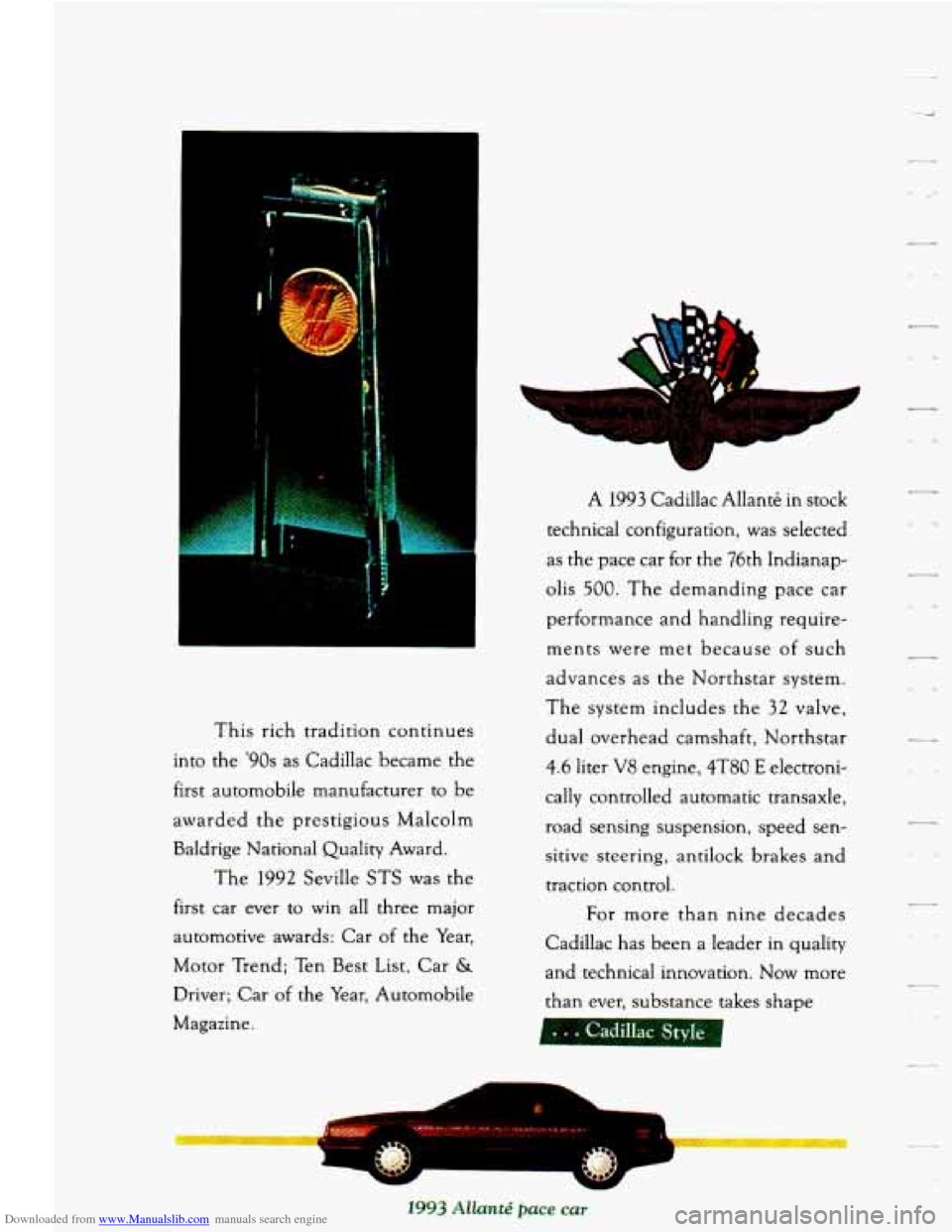
Downloaded from www.Manualslib.com manuals search engine --4
This rich tradition continues
into
the '90s as Cadillac became the
first automobile manufacturer
to be
awarded the prestigious Malcolm
Baldrige National Quality Award.
The
1992 Seville STS was the
first car ever to win all three major
automotive awards: Car
of the Year,
Motor Trend; Ten Best List, Car
&a
Driver; Car of the Year, Automobile
Magazine.
1
A 1993 Cadillac Allante in stock
technical configuration, was selected
as the pace car for the
76th Indianap-
olis
500. The demanding pace car
performance and handling require- ments were met because
of such
advances as the Northstar system.
The system includes the
32 valve,
dual overhead camshaft, Northstar
4.6 liter V8 engine, 4T80 E electroni-
cally controlled automatic transaxle,
road sensing suspension, speed sen-
sitive steering, antilock brakes and
traction control.
For more than nine decades
Cadillac has been a leader in quality
and technical. innovation. Now more
than ever, substance takes shape
L_
1993 Aliantk pace car
Page 96 of 410
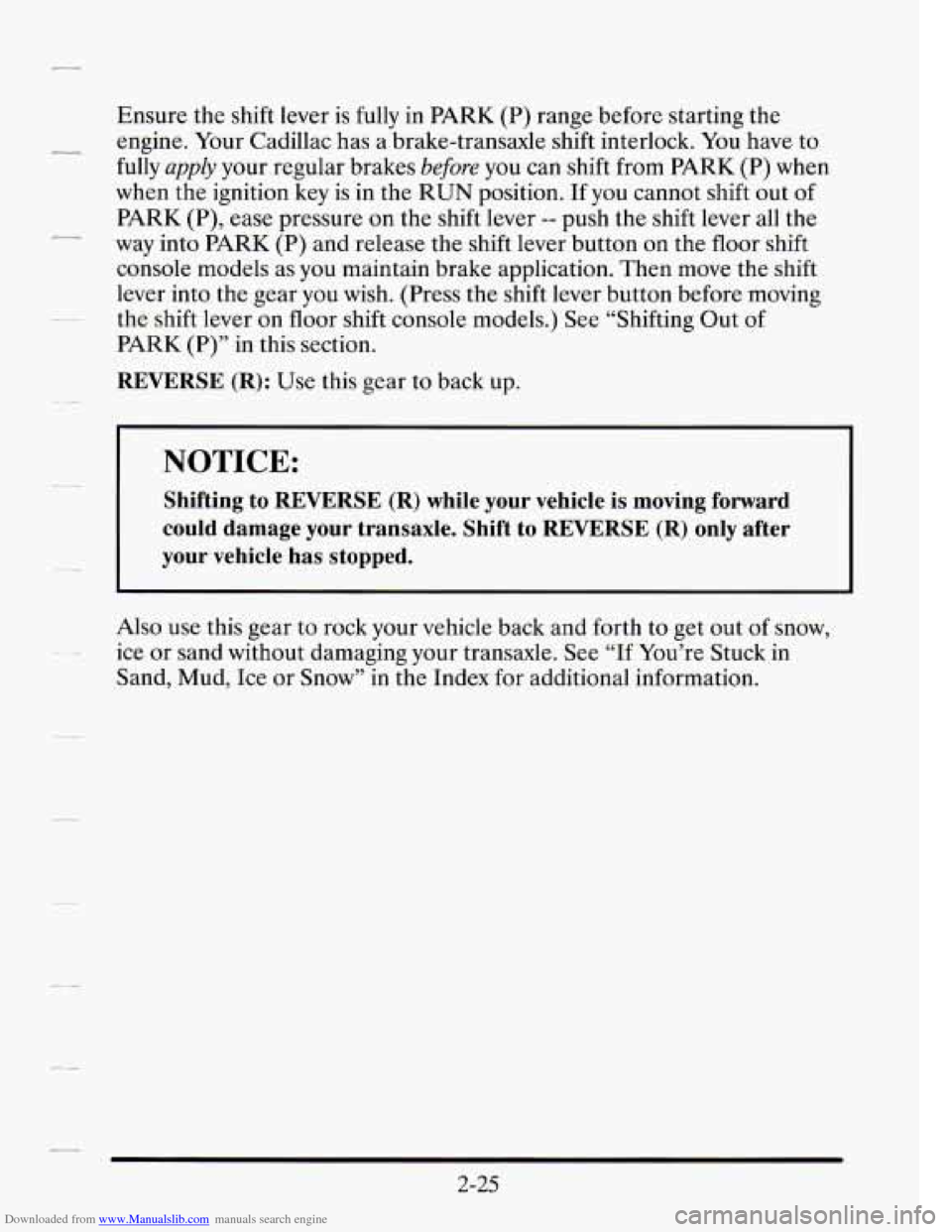
Downloaded from www.Manualslib.com manuals search engine Ensure the shift lever is fully in PARK (P) range before starting the
- engine. Your Cadillac has a brake-transaxle shift interlock. You have to
fully
apply your regular brakes before you can shift from PARK (P) when
when the ignition key is in the RUN position. If
you cannot shift out of
PARK (P), ease pressure on the shift lever -- push the shift lever all the
way into
PARK (P) and release the shift lever button on the floor shift
console models as you maintain brake application. Then move the shift
lever into the gear you wish. (Press the shift lever button before moving
PARK
(P)” in this section.
REVERSE (R): Use this gear to back up.
c_
- .~. the shift lever on floor shift console models.) See “Shifting Out of
NOTICE: -.- -
Shifting to REVERSE (R) while your vehicle is moving forward
could damage your transaxle. Shift to REVERSE (R) only after
. ~- your vehicle has stopped.
Also use this gear to rock your vehicle back and forth to get out of snow,
ice or sand without damaging your transaxle. See
“If You’re Stuck in
Sand, Mud, Ice or Snow” in the Index for additional information.
2-25
Page 99 of 410
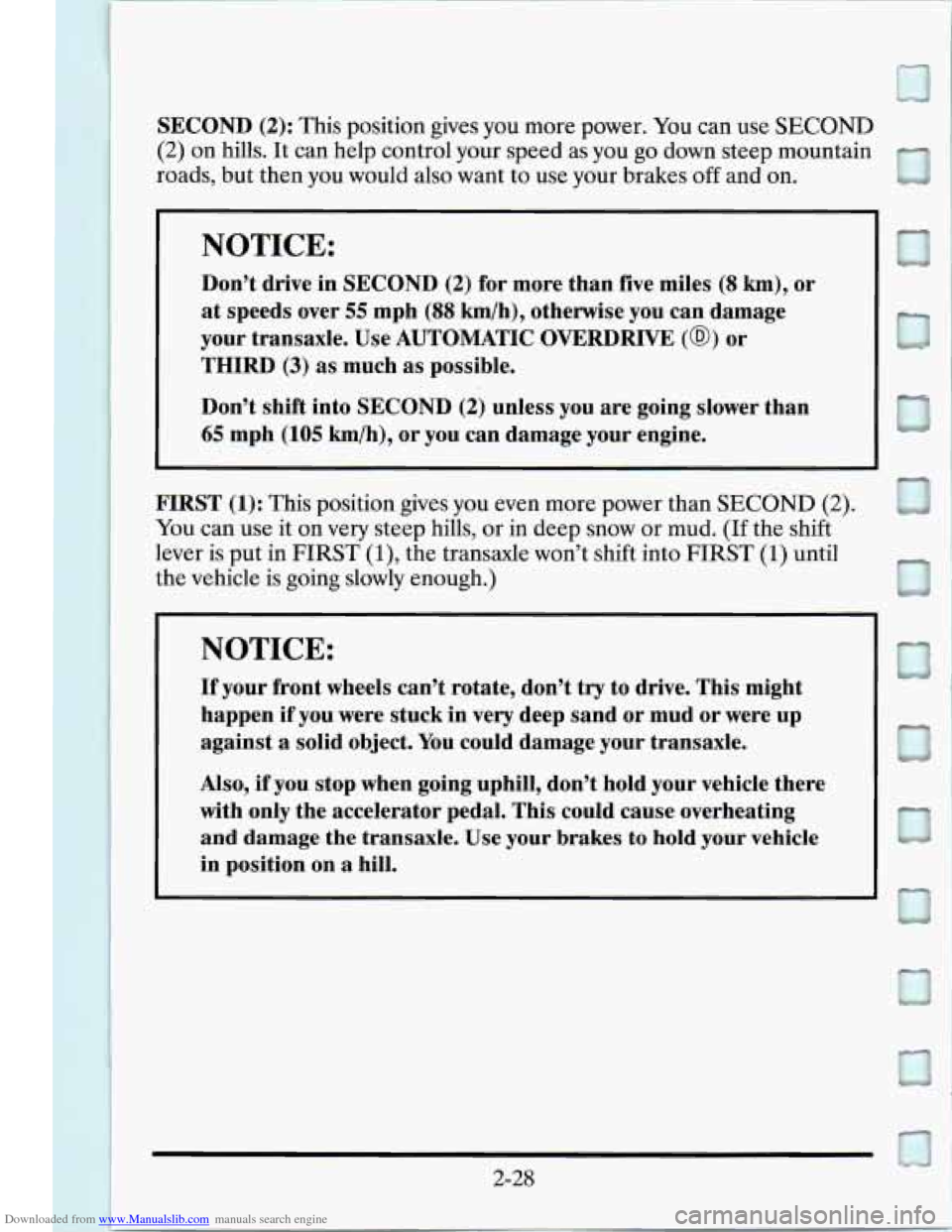
Downloaded from www.Manualslib.com manuals search engine SECOND (2): This position gives you more power. You can use SECOND
(2) on hills. It can help control your speed as you go down steep mountain 0
roads, but then you would also want to use your brakes off and on.
NOTICE:
Don’t drive in SECOND (2) for more than five miles (8 km), or
at speeds over 55 mph (88 km/h), otherwise you can damage
your transaxle. Use AUTOMATIC
OVERDRIVE (@) or
THIRD (3) as much as possible.
Don’t
shift into SECOND (2) unless you are going slower than
65 mph (105 km/h), or you can damage your engine.
FIRST (1): This position gives you even more power than SECOND (2).
You can use it on very steep hills, or in deep snow or mud. (If the shift
lever is put in
FIRST (l), the transaxle won’t shift into FIRST (1) until
the vehicle is going slowly enough.)
NOTICE:
If your front wheels can’t rotate, don’t try to drive. This might
happen
if you were stuck in very deep sand or mud or were up
against
a solid object. You could damage your transaxle.
Also, if you stop when going uphill, don’t hold your vehicle there
with only the accelerator pedal.
This could cause overheating
and damage
the transaxle. Use your brakes to hold your vehicle
in position on a hill.
g
Page 101 of 410
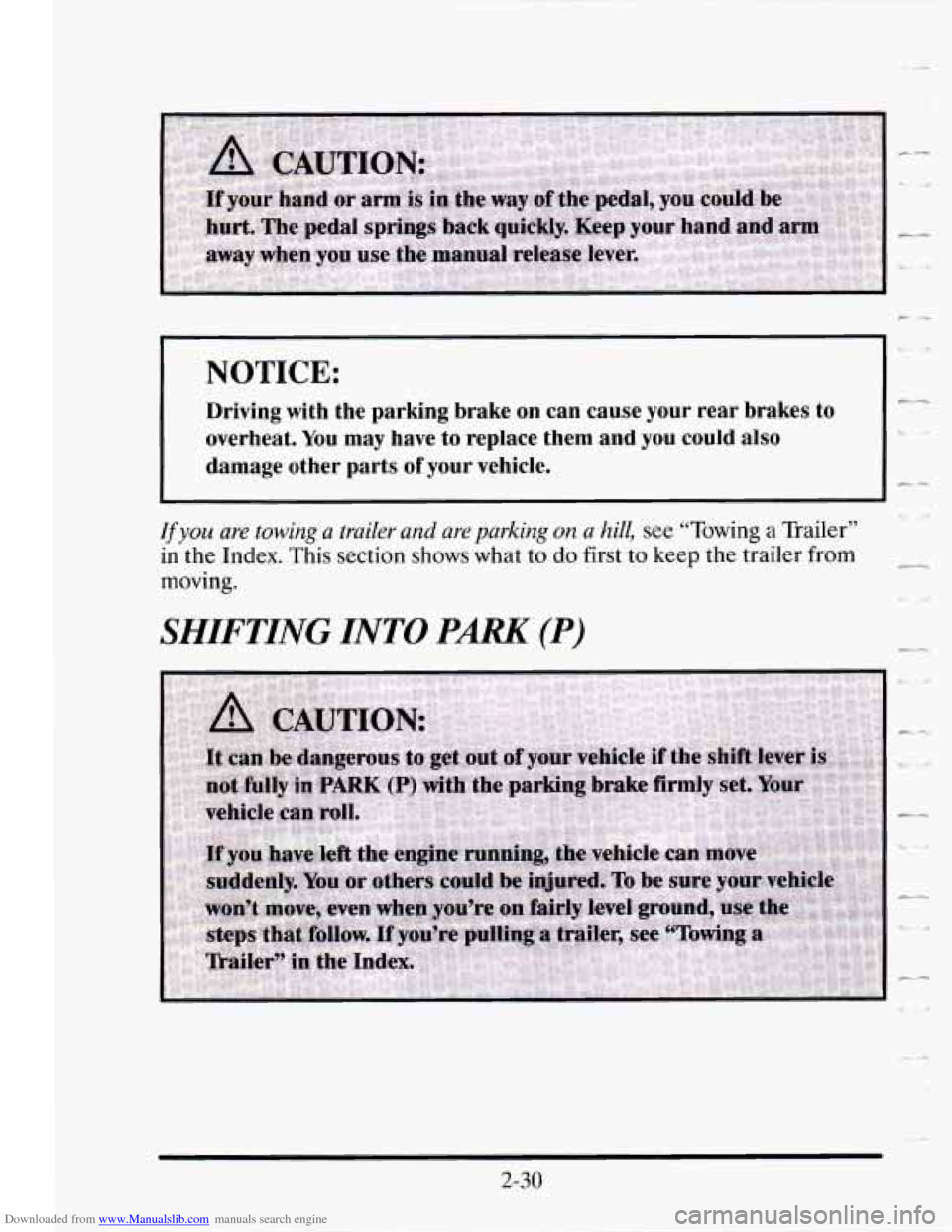
Downloaded from www.Manualslib.com manuals search engine I
NOTICE:
I- Driving with the parking brake on can cause your rear brakes \
to
overheat. You may have to replace them and you could also
damage other parts
of your vehicle. -. -
If you are towing a trailer and are parking on a hill, see “Towing a Trailer”
in the Index. This section shows what to do first to keep the trailer from
moving. c4
SHIFTING INTO PARK (P) c4
2-30
F-
Page 105 of 410
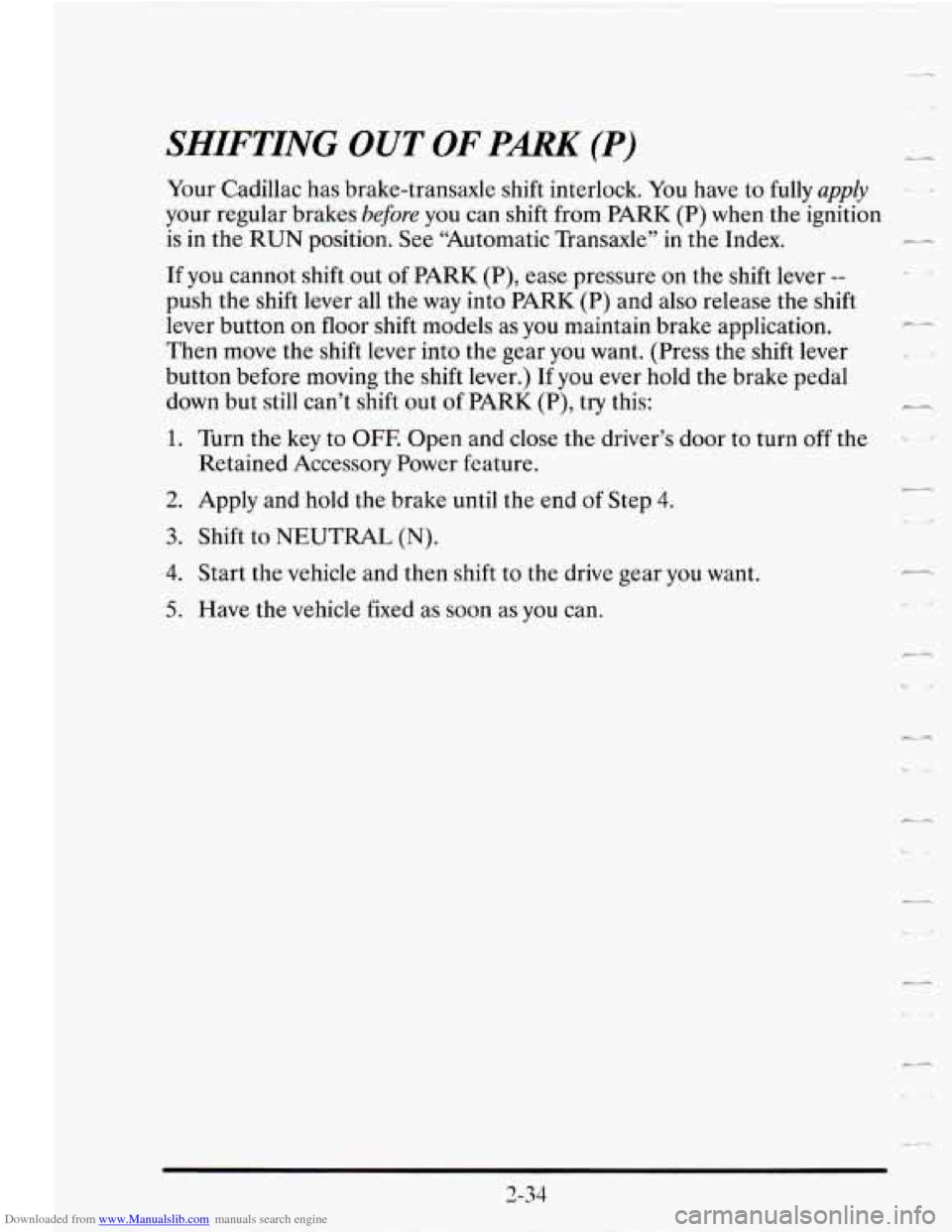
Downloaded from www.Manualslib.com manuals search engine SHIFTING OUT OF PARK (P)
Your Cadillac has brake-transaxle shift interlock. You have to fully apply 2
your regular brakes before you can shift from PARK (P) when the ignition
is in the RUN position. See “Automatic Transaxle” in the Index.
If
you cannot shift out of PARK (P), ease pressure on the shift lever --
push the shift lever all the way into PARK (P) and also release the shift
lever button on floor shift models as you maintain brake application.
e-.
Then move the shift lever into the gear you want. (Press the shift lever
button before moving the shift lever.)
If you ever hold the brake pedal
down but still can’t shift out of PARK
(P), try this:
1. Turn the key to OFF. Open and close the driver’s door to turn off the
Retained Accessory Power feature.
2. Apply and hold the brake until the end of Step 4.
3. Shift to NEUTRAL (N).
4. Start the vehicle and then shift to the drive gear you want.
5. Have the vehicle fixed as soon as you can.
3-34
Page 118 of 410
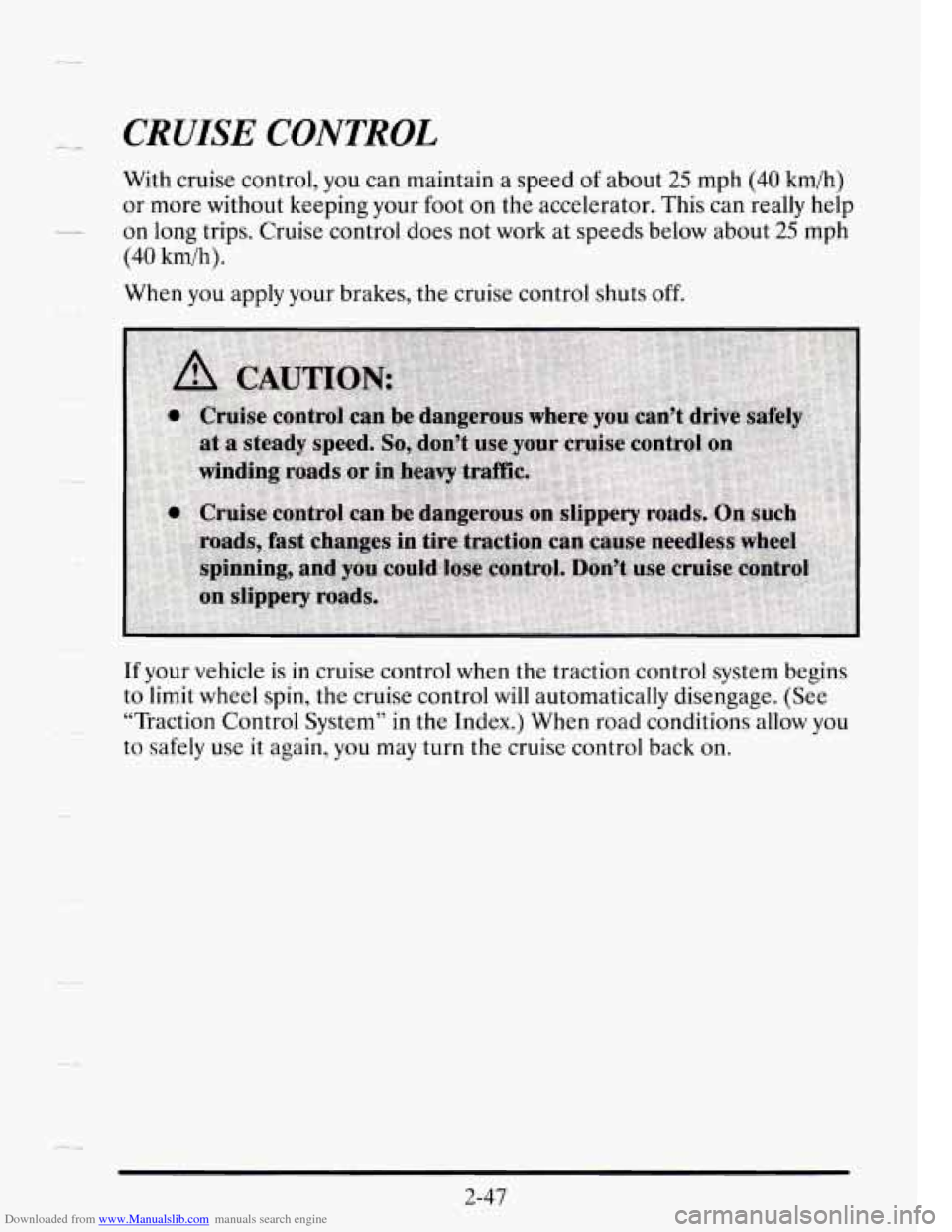
Downloaded from www.Manualslib.com manuals search engine -- CRUISE CONTROL
With cruise control, you can maintain a speed of about 25 mph (40 km/h)
or more without keeping your foot
on the accelerator. This can really help
(40 kmih).
When you apply your brakes, the cruise control shuts off.
-- on long trips. Cruise control does not work at speeds below about 25 mph
If your vehicle is in cruise control when the traction control system begins
to limit wheel spin, the cruise control will automatically disengage. (See
“Traction Control System”
in the Index.) When road conditions allow you
to safely use it again,
you may turn the cruise control back on.
A-
2-47
Page 151 of 410
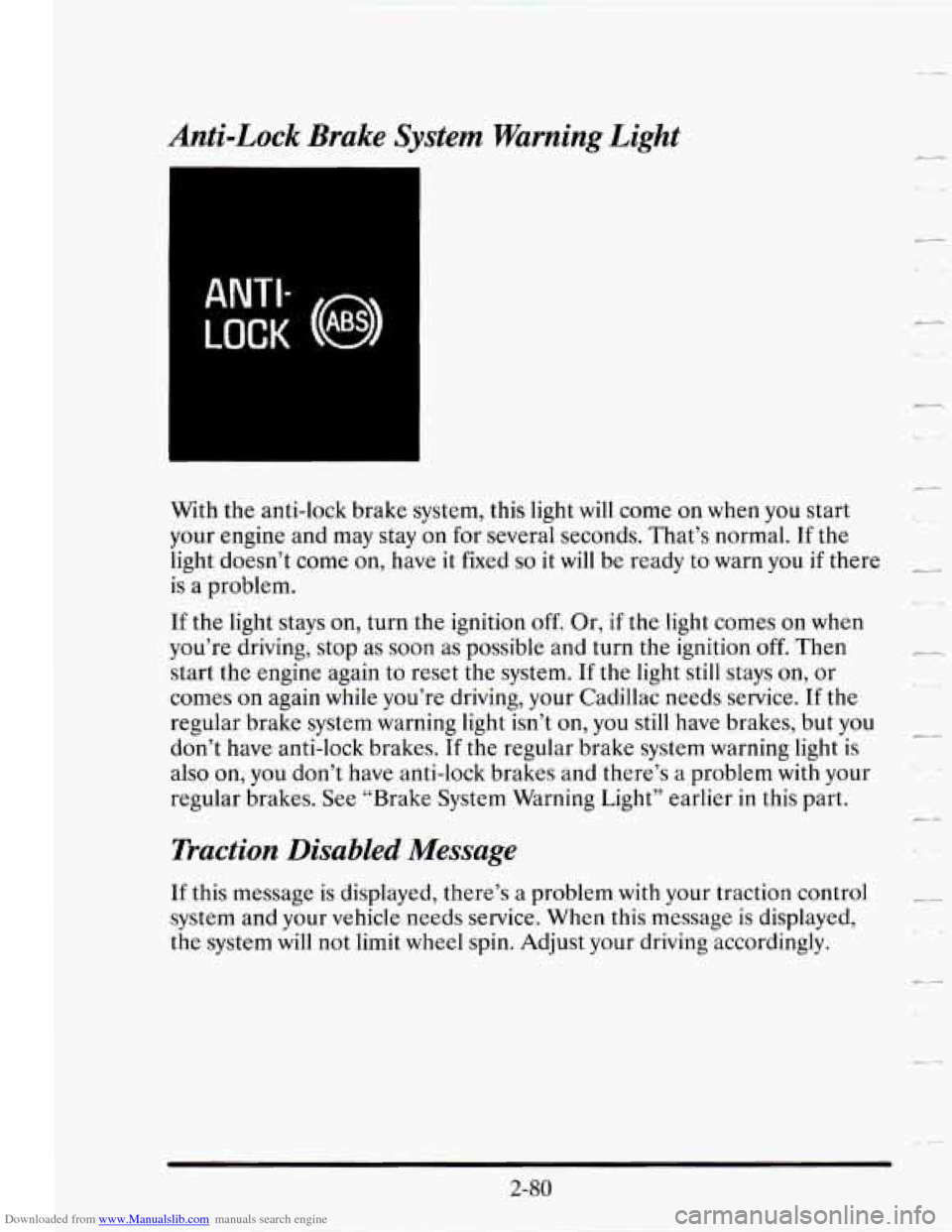
Downloaded from www.Manualslib.com manuals search engine Anti-Lock Brake System Warning Light
ANTI-
LOCK (0 ABS)
With the anti-lock brake system, this light will come on when you start
your engine and may stay on
for several seconds. That’s normal. If the
light doesn’t come on, have it fixed
so it will be ready to warn you if there
is a problem.
If the light stays on, turn the ignition off. Or, if the light comes on when
you’re driving, stop as soon as possible and turn the ignition
off. Then
start the engine again to reset the system. If the light still stays
on, or
comes on again while you’re driving, your Cadillac needs service.
If the
regular brake system warning light isn’t on, you still have brakes, but you
don’t have anti-lock brakes.
If the regular brake system warning light is
also on, you don’t have anti-lock brakes and there’s
a problem with your
regular brakes.
See “Brake System Warning Light” earlier in this part.
Traction Disabled Message
If this message is displayed, there’s a problem with your traction control
system and your vehicle needs service. When this message is displayed,
the system will not limit wheel spin. Adjust your driving accordingly.
-,.
c-
2-80
Page 197 of 410
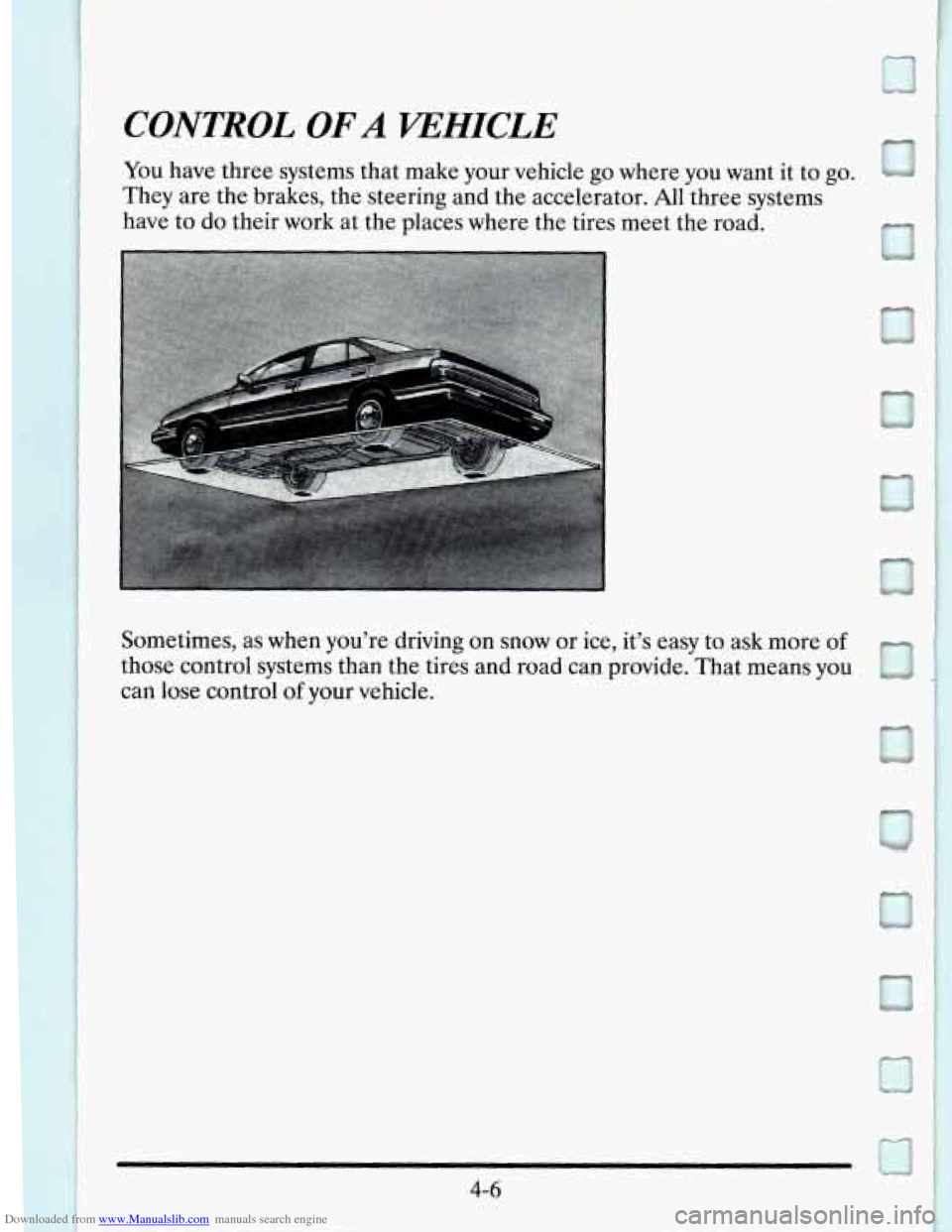
Downloaded from www.Manualslib.com manuals search engine CONTROL OFA VEHICLE 7
You have three systems that make your vehicle go where you want it to go. cd
They are the brakes, the steering and the accelerator. All three systems
have to do their work at the places where the tires meet the road.
Sometimes, as when you're driving on snow or ice, it's easy to ask more
of
those control systems than the tires and road can provide. That means you
can lose control
of your vehicle.
4-6
Page 198 of 410
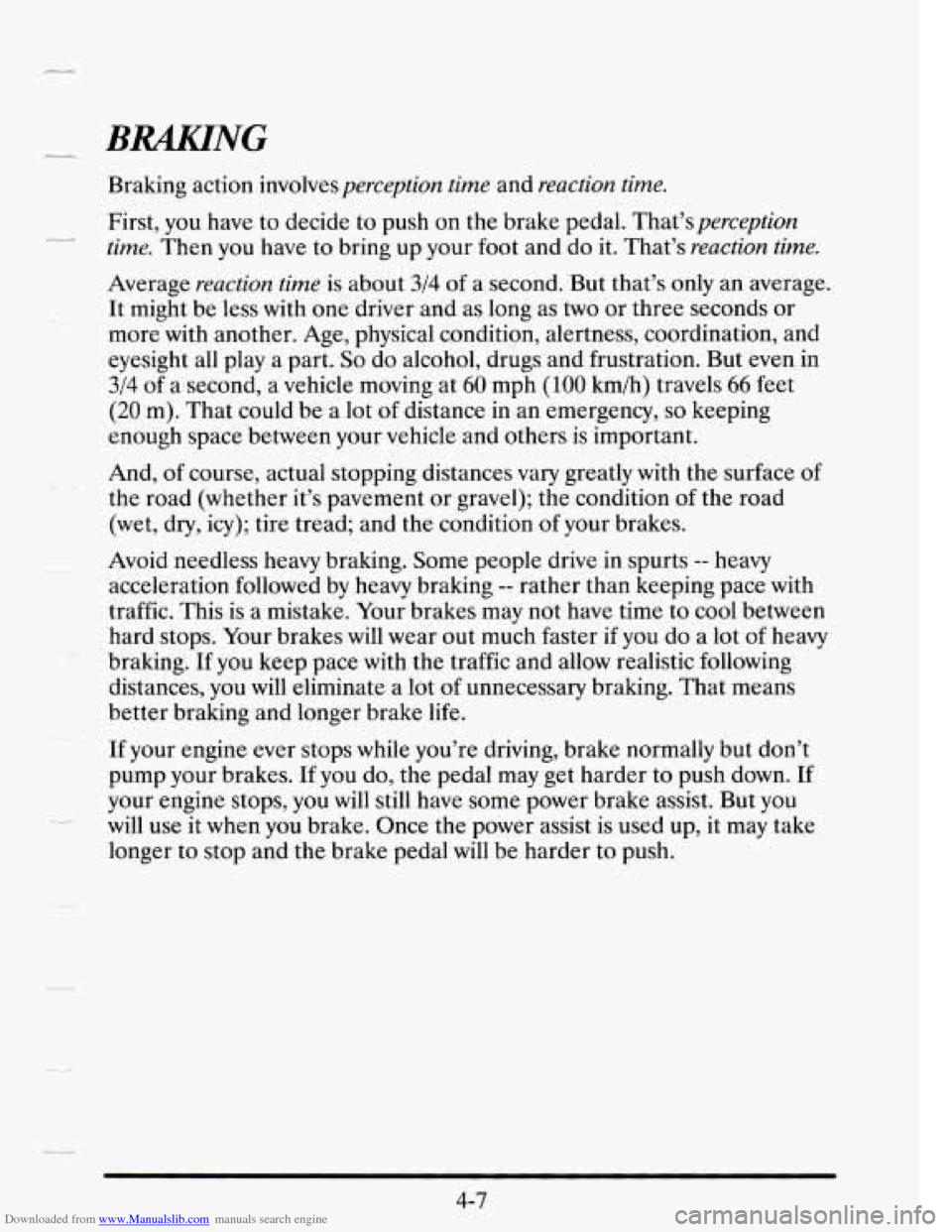
Downloaded from www.Manualslib.com manuals search engine Braking action involves perception time and reaction time.
First,
you have to decide to push on the brake pedal. That’sperception
time. Then you have to bring up your foot and do it. That’s reaction time.
Average reaction time is about
3/4 of a second. But that’s only an average.
It might be less with one driver and as long as
two or three seconds or
more with another. Age, physical condition, alertness, coordination, and
eyesight all play a part.
So do alcohol, drugs and frustration. But even in
3/4
of a second, a vehicle moving at 60 mph (100 km/h) travels 66 feet
(20 m). That could be a lot of distance in an emergency, so keeping
enough space between your vehicle and others is important.
And,
of course, actual stopping distances vary greatly with the surface of
the road (whether it’s pavement or gravel); the condition of the road
(wet, dry, icy); tire tread; and the condition
of your brakes.
Avoid needless heavy braking. Some people drive in spurts
-- heavy
acceleration followed by heavy braking
-- rather than keeping pace with
traffic. This is a mistake. Your brakes may not have time to cool between
hard stops. Your brakes will wear out much faster if
you do a lot of heavy
braking.
If you keep pace with the traffic and allow realistic following
distances, you will eliminate a lot
of unnecessary braking. That means
better braking and longer brake life.
If your engine ever stops while you’re driving, brake normally but don’t
pump your brakes. If you do, the pedal may get harder to push down. If
your engine stops, you will still have some power brake assist. But
you
will use it when you brake. Once the power assist is used up, it may take
longer to stop and the brake pedal will be harder to push.
4-7
Page 199 of 410
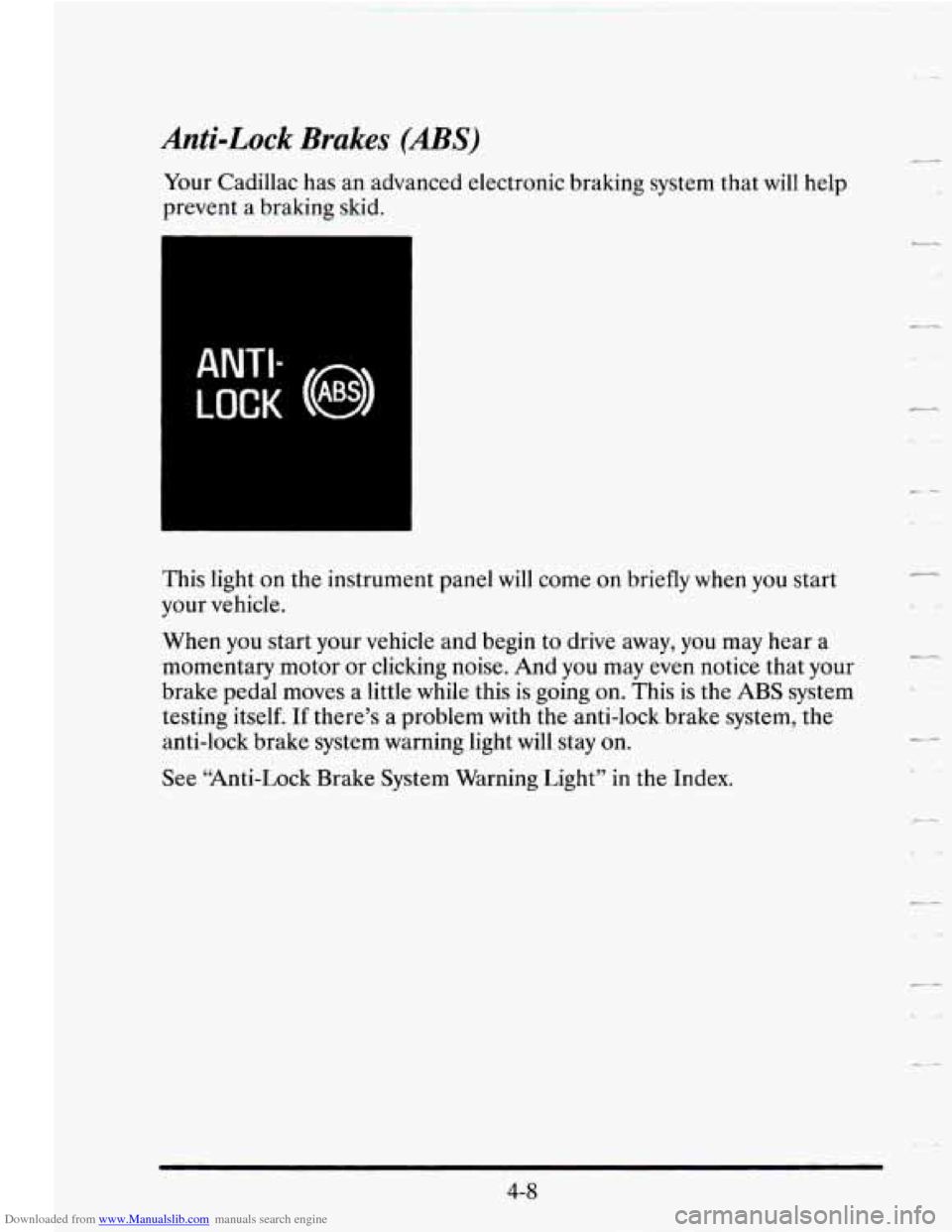
Downloaded from www.Manualslib.com manuals search engine Anti-Lock Brakes (ABS)
Your Cadillac has an advanced electronic braking system that will help
prevent a braking skid.
ANTI-
LOCK (0 ABS)
This light on the instrument panel will come on briefly when you start
your vehicle.
When you start your vehicle and begin to drive away, you may hear a
momentary motor or clicking noise.
And you may even notice that your
brake pedal moves a little while this is going on. This is the
ABS system
testing itself.
If there’s a problem with the anti-lock brake system, the
anti-lock brake system warning light will stay on.
See “Anti-Lock Brake System Warning Light” in the Index.
c-
-
c ..*
4-8